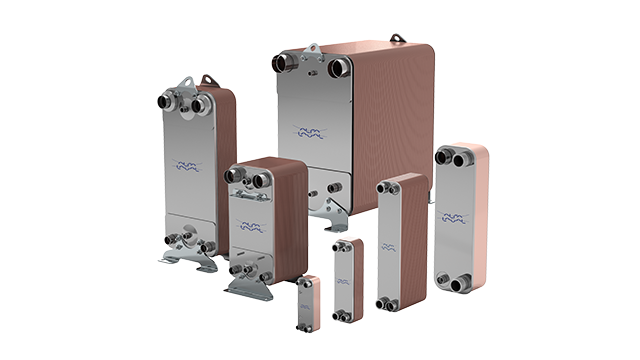AC
A linha AC de trocadores de calor de placas brasadas da Alfa Laval oferece transferência de calor eficiente em um design compacto. Esses equipamentos foram desenvolvidos especificamente para aplicações de ar-condicionado, refrigeração, chillers e bombas de calor.
Os trocadores de calor de placas brasadas são amplamente utilizados em plantas de refrigeração. Normalmente, são empregados para transferir calor do refrigerante — o fluido primário — para a água ou salmoura como fluido secundário.
As unidades da linha AC da Alfa Laval, com placas brasadas com cobre, são utilizadas principalmente como:
- Evaporadores para expansão seca e resfriamento de água
- Condensadores para rejeitar ou recuperar calor para a água
- Economizadores para resfriar o refrigerante líquido e superaquecimento do vapor de refrigerante
Também podem ser usados como:
- Subresfriadores para resfriar refrigerantes líquidos usando água de poço
- Trocadores intermediários no ciclo de absorção, para pré-aquecer a solução diluída ou pré-resfriar a solução concentrada
Como funciona

Os trocadores de calor de placas brasadas usados em aplicações HVAC normalmente utilizam um fluxo paralelo para alcançar a transferência de calor mais eficiente. Em um design de passagem única (single-pass), todas as conexões estão localizadas em um único lado do trocador de calor, o que facilita muito a instalação.
Padrão de canais alternados
Quando utilizado como evaporador, os canais formados entre as placas corrugadas e os cantos são dispostos de modo que os dois fluidos escoem por canais alternados, sempre em sentidos opostos (fluxo contracorrente). O refrigerante bifásico (vapor + líquido) entra pela parte inferior esquerda da unidade. A qualidade do vapor depende das condições operacionais do sistema de refrigeração.
Expansão seca
A evaporação da fase líquida ocorre dentro dos canais. Sempre é necessário certo grau de superaquecimento, por isso esse processo é chamado de “expansão seca”. As setas azul-escuro e azul-claro indicam a localização das conexões do refrigerante. A água (ou salmoura) a ser resfriada flui em contracorrente no canal oposto; as setas vermelho-escuro e vermelho-claro mostram onde estão localizadas as conexões da água ou salmoura.
Linha AC como condensador
Quando usado como condensador, os componentes principais permanecem os mesmos que no evaporador. O refrigerante entra pela parte superior esquerda como gás quente e começa a se condensar sobre a superfície dos canais. Uma vez completamente condensado, é ligeiramente sub-resfriado em um processo chamado “condensação livre”. As setas azul-escuro e azul-claro indicam a localização das conexões da salmoura. O refrigerante flui em contracorrente no canal oposto e é resfriado. As setas vermelho-escuro e vermelho-claro indicam onde estão localizadas as conexões do refrigerante.

